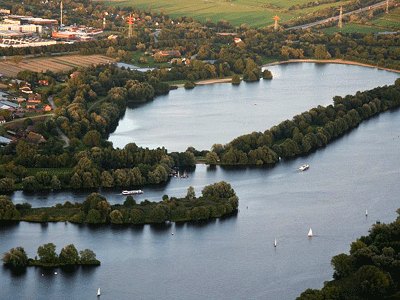Here is another reason not to urinate in lakes: human urine can cause the death of the fish population. Why does this happen to them and what can be done?

Lake Eichbaum where there is a high concentration of bacteria that cause the fish to die. Photo: Wiki-share
Lake Eichbaum (originally: Eichbaum see), near Hamburg, in northern Germany, is an artificial lake of fresh water, and is a center of attraction for fishing and recreation enthusiasts: swimming, bathing and sailing. In the middle of last May, due to finding about 500 fish carcasses floating in the lake, the lake was closed to all recreational activities. Researchers from the University of Hamburg began to try and locate the cause of death.
It turned out that the fish were poisoned by a toxin that affects the nervous system, known as Anatoxin A (in English: Anatoxin-a). Ontotoxin mimics the action of the acetylcholine molecule (the molecule that, as a result of its binding to the appropriate receptor, activates the muscle) at the nerve-muscle junction, and causes the muscle to be activated, but is not broken down by the cholinesterase enzyme (the enzyme that breaks down acetylcholine, thus allowing the muscle to stop its action) ) - and thus the muscles remain contracted.
As a result, a convulsion may occur, which, if it damages the respiratory muscles, causes death. There is no antidote to the toxin, and the treatment of the victims of the toxin is only symptomatic. In victims of the respiratory muscles, artificial respiration may save the patient's life. The concentration of the toxin in the lake water was fatal for the fish, but did not reach levels that endanger human life (the permeability of the substance to fish is high through the respiratory water passing through the gills; human skin is much less permeable)
Where does the toxin come from?
The natural source of the toxin is in several species of blue bacteria (cyanobacteria). These photosynthetic bacteria (incorrectly called, for historical reasons, also "blue algae") secrete the toxin into the lake water, and when their density in the lake water increases, so does the concentration of the toxin. Blue bacteria of various species inhabit seawater and even fresh water. These bacteria utilize the sun's radiation as a source of energy (phototrophs - carrying out photosynthesis); They absorb carbon from the CO2 molecules in the water (autotrophs - carbon fixers), and if necessary, they produce ammonia from molecular nitrogen (nitrogen fixers).
From this it follows that the main factor limiting them is the phosphorus. A "bloom" of blue bacteria usually breaks out in the lakes as a result of the flow of sewage of various types into the lake, as probably happened in our Kinneret in 1994/5 as a result of overflowing sewage into it. Indeed, there was a "bloom" of blue-green bacteria in the lake, of the Microcystis and Aphinozomenon genera - but not as a result of sewage entering the lake.
bacterial overgrowth
What caused the bacteria to "bloom" in the lake? The pH of the lake water varied from 7 (neutral) to 8.7 (alkaline); The increase in pH was caused by the urination of bathers in the lake (the authorities estimated about half a liter of urine per bather per day). The urine contains a source of nitrogen (urine - urea) and phosphorus compounds. The large amount of phosphorus compounds allowed the bacteria to thrive. Dispersing 148 tons of the substance Bentophos (a mineral based on the metal lanthanum, La57) in the lake, which is supposed to bind and deposit the phosphorus - thus preventing it from being available to bacteria - was not enough to immediately reduce the "bloom" of bacteria, but the hope is that it will reduce their growth in the future .
A similar phenomenon occurred in 2007, following which the lake was closed for three years, and opened again to the public in 2010. Now they are waiting for the "bloom" to disappear, and for the concentration of the toxin to decrease in order to open the lake again for recreational activities. Human activity affects the environment in different ways. Urinating in the lake was considered less serious - but this too, it turns out, has environmental consequences.
The full article was published in Galileo magazine, July 2012

6 תגובות
I don't understand not to pollute water there are no other normal places, why kill a living creature why, where is the concern?!
I am not at all surprised by these facts, given that every German on average drinks an average amount of a liter of beer on the weekend (at best) 🙂
What will the swimmers do who rattle with fear before swimming? Moshe Gretel should be consulted, in my opinion.
In short - let people pee where they want. At least that's what the Germans will let us do
A phenomenon of massive fish poisoning was also in South America near the coast of Tsila if I'm not mistaken? Not since this time was it published, when the cause of the mass death was not clear at the time.
Nothing changes in Germany:
"The authorities estimated about half a liter of urine for each bather per day"... Come on... then I said that nothing changes but it looks like they turned the place into a huge urinal and it's really a bit bizarre... until the PH levels of the entire lake change.
The lake is not very small, so how many people would have had to urinate there in order for such a crushing blow to be placed on this whole fish community...
Well, then we'll give up a lake in Germany this time and settle for the country pool near the house 🙂